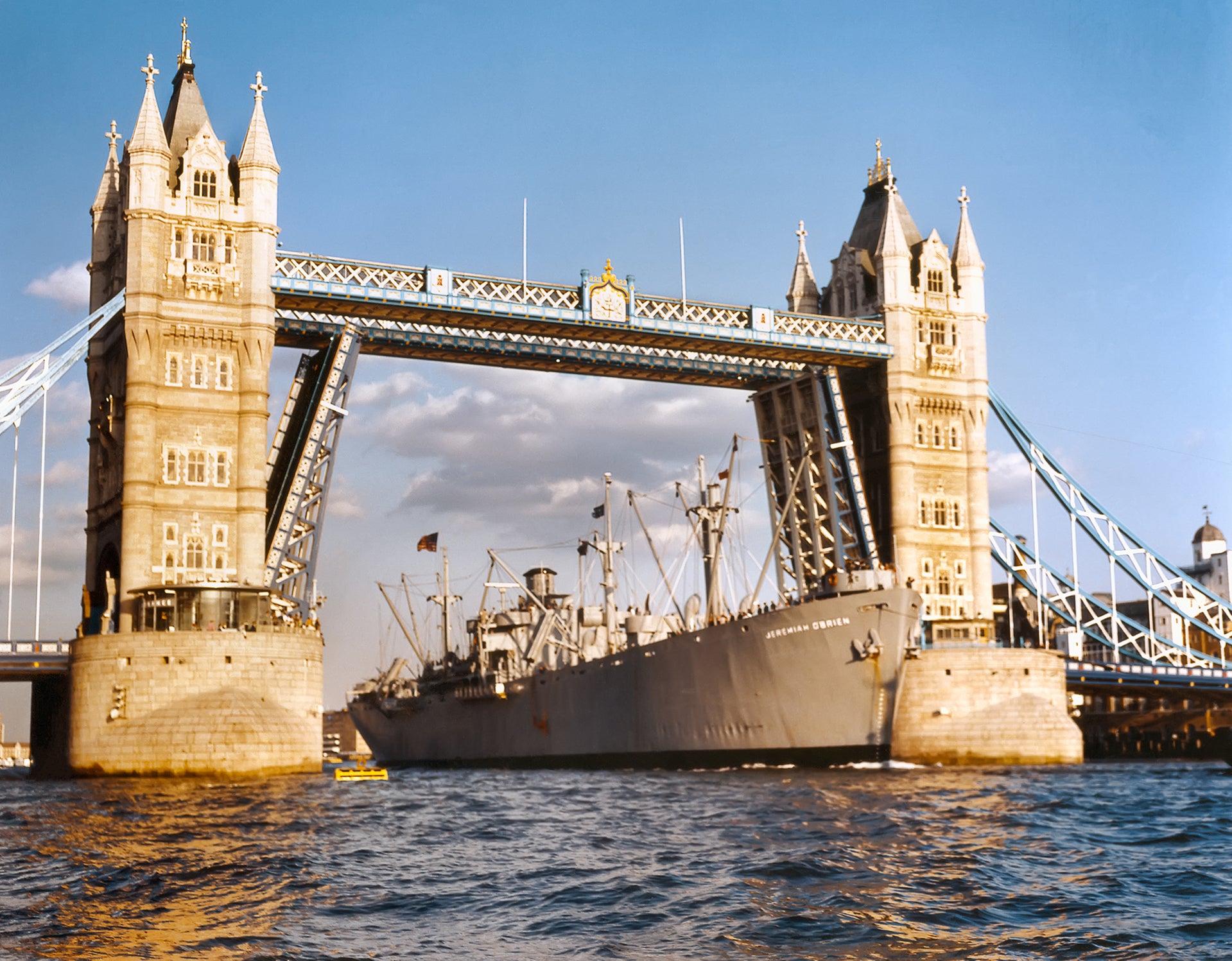
The Beginning of the O'Brien - 1940's
In June 1943 the Liberty Ship S.S. Jeremiah O'Brien slid down the ways at the New England Shipbuilding Corporation in South Portland, Maine. Shortly thereafter she entered service, operated by Grace Line for the War Shipping Administration. Named for the first American to capture a British naval vessel during the Revolutionary War, the O'Brien made seven World War II voyages, ranging from England and Northern Ireland to South America, to India, to Australia. She also made eleven crossings of the English Channel carrying personnel and supplies to the Normandy beaches in support of the D-Day invasion. After the war, she was "mothballed" and laid up in the Reserve Fleet at Suisun Bay, north of San Francisco.

Out of the Mothball Fleet - 1970's
Thirty-three years later, skillful maneuvering by U.S. Maritime Administration official Rear Adm. Thomas J. Patterson (himself a former Liberty ship sailor), saved the O'Brien from the scrap yard. In 1979, after hundreds of hours labor by volunteer crew members to remove thick layers of preservatives, the O'Brien headed for San Francisco to be restored. No other ship ever has steamed out of the mothball fleet under her own power. Following dry-docking, generous donations of money and supplies by numerous individuals and companies, and thousands of hours of restoration work by her volunteer crew, the old ship entered service on San Francisco Bay in like-new condition. She is a steaming memorial to the seamen of the U.S. Merchant Marine who served on Liberty ships in World War II, to their Navy gun crews, and to the civilian men and women who built the largest single class of ships in history: More than 2700 of these old-fashioned, homely, slow cargo vessels, that played such a vital, if unglamorous, role in winning World War II, were commissioned.

Return to Normandy - 1994
In 1994 the O'Brien, in what was to be an epic eighth voyage, steamed through the Golden Gate, down the west coast, through the Panama Canal, and across the Atlantic to England and France, where the O'Brien and her crew (a remarkable collection of old salts whose average age was 70 and a few cadets from the California Maritime Academy), participated in the 50th Anniversary of Operation Overlord -- the Allied invasion at Normandy that turned the tide of World War II in Europe. Of the more than 5,000 ships that formed the original D-Day armada, the O'Brien was the only ship to return 50 years later (although smaller vessels from many countries also returned). She and her crew were reviewed by the Queen of England from the royal yacht Britannia, visited by the President of the United States, and honored on both sides of the English Channel on that historic occasion. Returning across the Atlantic, her first U.S. port of call was her birthplace, South Portland, Maine. Continuing what was ultimately a six-month, 18,000 mile journey, she called at many other U.S. cities before making her triumphant return through the Golden Gate. The O'Brien made the entire voyage with no significant repairs and arrived at each port ahead of schedule -- a tribute to the skill and dedication of the volunteer crew members who maintained and sailed her, and a testimony to her sturdy design and construction.

Today and in the Future
The O'Brien is approved by the American Bureau of Shipping, certified by the U.S. Coast Guard, and fully seaworthy -- the only active Liberty Ship in original configuration. Operated as the National Liberty Ship Memorial, she is moored at Pier 35, Fisherman's Wharf and open to the public most days. Virtually the entire ship from engine room to flying bridge can be seen by visitors. Boilers are "lit off," and the 2500-horsepower, triple-expansion reciprocating steam main engine is operated on Steaming Weekends (normally the third Saturday and Sunday of each month) so visitors can see the engine plant in action. Several San Francisco Bay cruises are scheduled each year. Be sure to check our calendar for Steaming Weekends and cruise schedules. The ship relies on the work of her hundreds of volunteer crew members, funding from individual and corporate donations, and revenue from the thousands of visitors she hosts each year. Ship's hours, cruise schedules, and other information are available on this website. One other Liberty ship is known to be active — the S.S. John W. Brown in Baltimore: Modified into troopship configuration during WW II, she underwent further modifications during many years as a school ship in New York before beginning her current life as a museum vessel.
